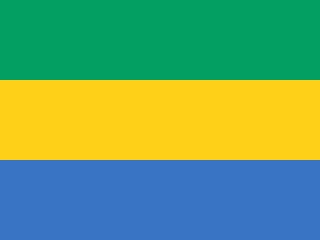
Gabon, officially the Gabonese Republic, is a country on the west coast of Central Africa. Located on the equator, it is bordered by Equatorial Guinea to the northwest, Cameroon to the north, the Republic of the Congo on the east and south, and the Gulf of Guinea to the west. It has an area of nearly 270,000 square kilometres (100,000 sq mi) and its population is estimated at 2.3 million people. There are coastal plains, mountains, and a savanna in the east.

French is the official language in Gabon, however 32% of the people speak Fang as a mother tongue. French is the medium of instruction. Before World War II very few Gabonese learned French, nearly all of them working in either business or government administration. After the war, France worked for universal primary education in Gabon, and by the 1960-61 census, 47% of the Gabonese over the age of 14 spoke some French, while 13% were literate in the language. By the 1990s, the literacy rate had risen to about 60%.
The Adouma are an ethnic group of Gabon, in central Africa. They primarily live on the South bank of the upper Ogooué River, in the vicinity of Lastoursville, and are known as expert canoeists or the boatmen. They speak Duma, a Nzebi language of the Bantu family.

Ngounié is a province of south-central Gabon covering an area of 3,775 kilometres (2,346 mi). Its capital is Mouila. At the 2013 census it had 100,838 inhabitants. In 2016, its governor was Benjamin Nzigou.

The Bunak language is the language of the Bunak people of the mountainous region of central Timor, split between the political boundary between West Timor, Indonesia, particularly in Lamaknen District and East Timor. It is one of the few on Timor which is not an Austronesian language, but rather a Papuan language of the Timor-Alor-Pantar language family. The language is surrounded by Malayo-Polynesian languages, like Uab Meto and Tetum.

Kiga is a Great Lakes Bantu language of the Kiga people (Bakiga). Kiga is a similar and partially mutually intelligible with the Nkore language. It was first written in the second half of the 19th century. Kiga is largely spoken in the ancient Kigezi region which includes about 5 districts, namely Rubanda, Rukiga, Kabale, Kanungu and some parts of Rukungiri. As of 2021, Kiga is spoken natively by about 1.3 million people in Uganda.

The Namakura language, Makura or Namakir, is an Oceanic language of Vanuatu. The language is spoken in Shefa Province, north Efate, Tongoa, and Tongariki.
Zande is the largest of the Zande languages. It is spoken by the Azande, primarily in the northeast of the Democratic Republic of the Congo and western South Sudan, but also in the eastern part of the Central African Republic. It is called Pazande in the Zande language and Kizande in Lingala.
Lugbara, or Lugbarati, is the language of the Lugbara people. It is spoken in the West Nile region in northwestern Uganda, as well as the Democratic Republic of the Congo's Orientale Province.
Semelai is an Austroasiatic language spoken in the Malay Peninsula. It belongs to the Southern branch of the Aslian language subgrouping. The Semelai reside predominantly around the Bera, Serting and associated river systems in the states of Pahang, Negeri Sembilan and Johor.

Achagua, or Achawa, is an Arawakan language spoken in the Meta Department of Colombia, similar to Piapoco. It is estimated that 250 individuals speak the language, many of whom also speak Piapoco or Spanish.
Maba is a Maban language spoken in Chad and Sudan. It is divided into several dialects, and serves as a local trade language. Maba is closely related to the Masalit language.
Waurá (Wauja) is an Arawakan language spoken in the Xingu Indigenous Park of Brazil by the Waujá people. It is "partially intelligible" with Mehináku. The entire population speaks the language.
Cebaara (Tyebala), one of a cluster of languages called Senari, is a major Senufo language, spoken by a million people in Ivory Coast.
The Nzebi languages are a series of Bantu languages spoken in the western Congo and in Gabon. They are coded Zone B.50 in Guthrie's classification. According to Nurse & Philippson (2003), the Nzebi languages form a valid node with West Teke (B.70). The languages are:
North Teke, or Tɛgɛ, is a member of the Teke languages dialect continuum of the Congolese plateau.
Yamdena is an Austronesian language of Yamdena and surrounding islands in the Maluku Islands in Indonesia.
Kayan is a dialect cluster spoken by the Kayan people of Borneo. It is a cluster of closely related dialects with limited mutual intelligibility, and is itself part of the Kayan-Murik group of Austronesian languages.
Na is a language of the Naish subbranch of the Naic group of the Sino-Tibetan languages.

Seba Charmelle Scholastique known as SeBa is a Gabonese singer. She sings in the Nzebi language, but it is her use of Italian that gained her a knighthood. She has published several albums since her first in 2006.








